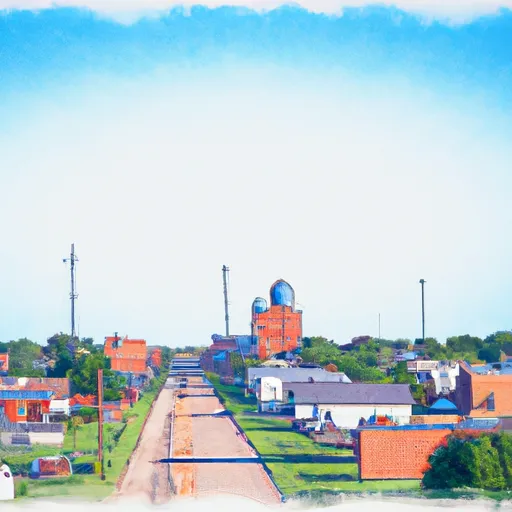-
 Snoflo Premium
Snoflo Premium
Get unlimited access to all our content
With no Ad interruptions! - Start Your Free Trial Login with existing account
Wilcox
Eden Index
Climate
7.8
•
Recreation
0.9
•
Community
1.6
•
Safeguard
3.8/10

Wilcox, Nebraska is a small rural town located in Kearney County, in the central part of the state. The region experiences a humid continental climate, characterized by hot summers and cold winters. Average high temperatures range from around 90°F (32°C) in the summer to about 35°F (2°C) in the winter, while average lows range from 65°F (18°C) to 15°F (-9°C) respectively. Precipitation is fairly evenly distributed throughout the year, with an average annual rainfall of around 26 inches.
Hydrologically, Wilcox lies within the Platte River Basin. The area is known for its rich agricultural lands and contains several streams and small tributaries that eventually flow into the Platte River. Due to its location in a predominantly agricultural region, water quality and quantity are important considerations for the local community.
For outdoor enthusiasts, Wilcox offers a variety of recreational opportunities. The region is dotted with beautiful parks, nature reserves, and wildlife management areas. Visitors can enjoy activities such as fishing, hunting, camping, hiking, and bird-watching in these natural areas. The nearby Platte River also provides opportunities for boating, kayaking, and canoeing. With its scenic landscapes and abundant wildlife, Wilcox offers a peaceful retreat for nature lovers and outdoor enthusiasts alike.
What is the Eden Index?
The Snoflo Eden Index serves as a comprehensive rating system for regions, evaluating their desirability through a holistic assessment of climate health, outdoor recreation opportunities, and natural disaster risk, acknowledging the profound impact of these factors on livability and well-being.
Climate Health Indicator (CHI): 7.8
Wilcox receives approximately
634mm of rain per year,
with humidity levels near 82%
and air temperatures averaging around
11°C.
Wilcox has a plant hardyness factor of
5, meaning
plants and agriculture in this region thrive during a short period during spring and early summer. Most
plants will die off during the colder winter months.
By considering the ideal temperature range, reliable water supplies, clean air, and stable seasonal rain or snowpacks, the Climate Health Indicator (CHI) underscores the significance of a healthy climate as the foundation for quality living.
A healthy climate is paramount for ensuring a high quality of life and livability in a region, fostering both physical well-being and environmental harmony. This can be characterized by ideal temperatures, reliable access to water supplies, clean air, and consistent seasonal rain or snowpacks.
Weather Forecast
Streamflow Conditions
Republican
Area Rivers
Republican
Snowpack Depths
Republican
Reservoir Storage Capacity
Republican
Groundwater Levels
Recreational Opportunity Index (ROI): 0.9
The Recreational Opportunity Index (ROI) recognizes the value of outdoor recreational options, such as parks, hiking trails, camping sites, and fishing spots, while acknowledging that climate plays a pivotal role in ensuring the comfort and consistency of these experiences.
Access to outdoor recreational opportunities, encompassing activities such as parks, hiking, camping, and fishing, is crucial for overall well-being, and the climate plays a pivotal role in enabling and enhancing these experiences, ensuring that individuals can engage in nature-based activities comfortably and consistently.
Camping Areas
| Campground | Campsites | Reservations | Toilets | Showers | Elevation |
|---|---|---|---|---|---|
| Gremlin Cove - Harlan County Lake | 100 | 1,968 ft | |||
| Holdrege City Park | None | 2,312 ft | |||
| Phillipsburg City Park | None | 1,874 ft | |||
| Hunter Cove - Harlan County Lake | 160 | 1,970 ft | |||
| South Outlet - Harlan County Lake | 60 | 1,886 ft | |||
| North Outlet - Harlan County Lake | None | 1,920 ft | |||
| Union Pacific State Rec Area | 5 | 2,199 ft | |||
| Stockton City Park | 5 | 1,762 ft | |||
| Fort Kearny State Rec Area | 110 | 2,110 ft | |||
| Methodist Cove - Harlan County Lake | 155 | 1,981 ft |
Catastrophe Safeguard Index (CSI):
The Catastrophe Safeguard Index (CSI) recognizes that natural disaster risk, encompassing floods, fires, hurricanes, and tornadoes, can drastically affect safety and the overall appeal of an area.
The level of natural disaster risk in a region significantly affects safety and the overall livability, with climate change amplifying these risks by potentially increasing the frequency and intensity of events like floods, fires, hurricanes, and tornadoes, thereby posing substantial challenges to community resilience and well-being.
Community Resilience Indicator (CRI): 1.6
The Community Resilience Indicator (CRI) recognizes that education, healthcare, and socioeconomics are crucial to the well-being of a region. The CRI acknowledges the profound impact of these elements on residents' overall quality of life. By evaluating educational resources, healthcare accessibility, and economic inclusivity, the index captures the essential aspects that contribute to a thriving community, fostering resident satisfaction, equity, and social cohesion.

